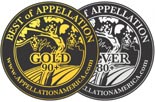
 Maryland has been at the forefront of American viticultural research since the mid-1600s when Lord Baltimore ordered vines to be planted. Since then, viticulturists have explored almost every vine type, from native American species to wild and man-made hybrids, not to mention numerous attempts at classic European varieties. In modern times it was the indomitable Philip Wagner who blazed a trail with diverse experimental plantings of hybrids. Wagner would eventually open Boordy Vineyards, Maryland’s first winery, in 1945. He would also write Grapes Into Wine, the best selling book on winemaking in America.
Maryland has been at the forefront of American viticultural research since the mid-1600s when Lord Baltimore ordered vines to be planted. Since then, viticulturists have explored almost every vine type, from native American species to wild and man-made hybrids, not to mention numerous attempts at classic European varieties. In modern times it was the indomitable Philip Wagner who blazed a trail with diverse experimental plantings of hybrids. Wagner would eventually open Boordy Vineyards, Maryland’s first winery, in 1945. He would also write Grapes Into Wine, the best selling book on winemaking in America.
Today, the state’s wine production totals almost 100,000 cases annually, derived from 450 acres of vines and more than 30 farm wineries. Activity is concentrated in eastern Maryland on coastal lands surrounding Chesapeake Bay and on the Piedmont Plateau, north and west of Baltimore. A wide range of climactic zones are found, including everything from very cold to quite hot areas.
In the early days of AVA designation, Maryland responded quickly with three appellations (Linganore, Cumberland Valley and Catoctin) recognized before the end of the 1980s. Of these designations, only Linganore enjoys much currency today, and most wineries prefer to use the Maryland (state) appellation to identify the origin of their wines.
|
|
Current Feature
In the southern Blue Ridge Mountains of North Carolina and Georgia vineyards are small and few, yet the establishment of the Upper Hiwassee Highlands could bring much more.
[>] continue
Appellation Features
[>] see all Maryland features (2)
Related Features
Best of Appellation
See the best wines of
Maryland
Alive & Well here

Cabernet Franc:
Although rarely the center of attention, Cabernet Franc, your congenial nature makes you a pleasure
[>] continue



 Bi-State Upper Hiwassee Highlands an AVA
Bi-State Upper Hiwassee Highlands an AVA  Maryland Wine & Grape Advisory Committee Report Released
Maryland Wine & Grape Advisory Committee Report Released  Remedy for the Winter Doldrums
Remedy for the Winter Doldrums  Remote Manton Valley New California AVA
Remote Manton Valley New California AVA WAWGG Banquet Explores Washington State Terrior
WAWGG Banquet Explores Washington State Terrior Taking Focus on Appellation
Taking Focus on Appellation Whitehall Lane Winery, A 20 Year Story of Vineyards
Whitehall Lane Winery, A 20 Year Story of Vineyards Embracing Virginia’s Terroir
Embracing Virginia’s Terroir  Appellation America to Drop Paywall - Provide Open Access
Appellation America to Drop Paywall - Provide Open Access

